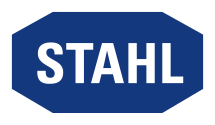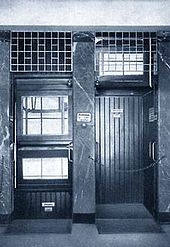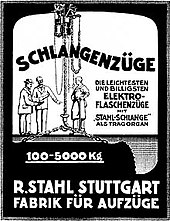R. Stahl
| R. STAHL AG
|
|
|---|---|
| legal form | Corporation |
| ISIN | DE000A1PHBB5 |
| founding | 1876 |
| Seat |
Waldenburg , Germany |
| management | |
| Number of employees | 1,669 |
| sales | 274.8 million euros |
| Branch | Electrical engineering manufacturer (explosion protection) |
| Website | www.r-stahl.com |
| As of December 31, 2019 | |
The R. Stahl AG is a listed supplier of products, systems and services for explosion protection with headquarters in Waldenburg in Hohenlohe in Baden-Wuerttemberg .
Products
R. Stahl manufactures, among other things, explosion-proof switchgear, buttons, lights and controls. The main buyers of the products are in the gas and oil industry, in the chemical and pharmaceutical industry as well as in the food industry and in shipbuilding. With a market share of 14% in relation to sales, the company is number two worldwide in electrical explosion protection and is the technology leader and the only provider of complex system solutions.
history
Rafael Stahl (1845–1899) founded the mechanical workshop Stahl und Weineck in Stuttgart on August 1, 1876 after completing his training as a fitter . The workshop manufactured, among other things, circular knitting machines for the manufacture of tricot fabrics and other products for the textile industry . From the mid-1880s, Rafael Stahl led the company alone, having previously had different partners; the company was renamed Maschinenfabrik R. Stahl . Stahl now also marketed its circular knitting machines abroad and supplied complete equipment for jersey factories. Due to the declining demand for these materials, the business area of the machine factory shifted : with the construction of the first manual winding, in which primarily one of his three sons, Rafael Stahl jun., Was able to contribute his engineering knowledge, the further expansion of the from 1893 itself developed conveyor technology. In the following years, R. Stahl expanded the product range to include electric elevators and bridge cranes. Above all, hoists and heavy iron structures were produced. In 1897 R. Stahl presented the first electric elevator, parallel to it a bridge crane with a 12.5 tonne load capacity and 11.50 meter span. At the beginning of the 20th century, electrical energy increasingly replaced steam as the driving force. From 1903 onwards, Stahl consistently focused on the production of electric pulley blocks. For the first time they used a calibrated round link chain as a means of support. From 1908 the factory also manufactured passenger paternosters , the first system was installed in the Graf-Eberhard-Bau in Stuttgart.
In addition to Rafael and Karl, the founder's third son, Hugo Stahl, had been working in the company since 1906. In particular, he was instrumental in promoting the patent for the R. Stahl snake train. The special feature of this snake hoist is the link chain, which is flexible on all sides and acts as a carrying tool for the chain hoists that can lift up to five tons. The precise, quiet and fast hoist was presented at the Leipzig trade fair and soon proved to be a bestseller.
The first type SS electric wire rope hoist followed in 1922 with a reeled wire rope as a supporting element. Greater lifting heights and speeds opened up new areas of application. The company employed a quarter of all industrial workers working in Stuttgart-Wangen in the mid-1920s. In response to demand from large chemical industries, Stahl was the first manufacturer to develop explosion-proof hoists in 1926. A few years later, the global economic crisis did not stop at R. Stahl either. Nevertheless, the innovations continued: the two-part BA rope hoist with a drive motor in the drum and loads of up to five tons came onto the market. In 1944 the company relocated electric train construction from Stuttgart to Künzelsau . After the war, the company developed new explosion-proof switchgear for elevator systems. R. Stahl developed into the largest German elevator manufacturer and one of the leading companies for rope and chain hoists and became one of the market leaders in the field of explosion-proof electrical equipment.
In 1950 R. Stahl Electus before, an electric chain hoist with round link chain, a novel planetary gear and direct circuit via a push-button control bulb. Up until then, round link chains were considered unsuitable for suspension equipment because the demands on wear resistance and tolerance of the chain links were too high. On the other hand, a 23 kilogram Elektus was able to lift 22 times its own weight - 500 kg. In 1952, the production of type C rope hoists began , which were manufactured in a modular system and lifted loads of up to 16 tons. The fine and main lift gave him clear advantages in daily use. A short time later, the very close cooperation with the Physikalisch-Technische Bundesanstalt (PTA) in Braunschweig began, which tests all explosion-protected lifting equipment and components for conformity and often works closely with the R. Stahl technicians.
In 1961, chain hoist production started in the new factory in Künzelsau-Hofratsmühle. Three years later, the move to a series crane manufacturer followed with the first standard crane program. Head girders, crane girders, trolleys and controls were standardized, networked to form a modular system and in this way adapted quickly and cost-effectively to the ever more diverse requirements of customers. In 1965 the company merged with A. Zaiser, a Stuttgart company with elevator and escalator business. In 1967 the elevator for the 540 meter high Moscow television tower was built - a world record at the time. In 1969 R. Stahl took over the traditional crane builder Zurstrassen, shortly afterwards the production of standard cranes was relocated to the company's headquarters in Ettlingen near Karlsruhe. In 1970 the elevator construction division was sold to Rheinstahl . In the 1980s, the business areas were spun off into subsidiaries.
The company has operated as a stock corporation since 1993 and has been listed on the stock exchange since 1997. The new SH rope hoist followed when the company went public . In 26 sizes, the SH wire rope hoist covers the load range up to 25 tons, supplemented by the AS70 wire rope hoist, which has been available since 1993 and is available up to 100 tons. At the same time, the ST chain hoists for loads from 125 to 5000 kilograms were presented.
On January 1, 2006, R. Stahl sold the conveyor technology division to the Finnish group KCI Konecranes , based in Hyvinkää (60 km north of Helsinki ). The employees as well as the sales and production locations moved to the new Stahl CraneSystems GmbH. R. Stahl focuses on explosion protection.
Mathias Hallmann has been CEO of R. Stahl AG since January 1, 2018, succeeding CEO Martin Schomaker.
Takeover offer
On April 10, 2014, the Weidmüller Group announced a voluntary takeover offer to purchase at least 50% of the company's shares. At the end of April, representatives of the founding families, who jointly held over 50% of the shares, declared that they had committed not to sell their shares. Nonetheless, the offer was opened on May 20 with a term until June 17, 2014 and increased to € 50 per share on June 13 with a term until July 1. The offer expired on July 1, 2014, with an acceptance rate of around 19%. During the takeover offer, there was also criticism of the conduct of the management board and the founding families. The total costs of the takeover defense amounted to around € 5 million.
Corporate structure
Holdings
The holding company has 34 subsidiaries. The holding company is directly represented by subsidiaries in 24 countries. The production sites are in Germany (Waldenburg, Weimar, Cologne), the Netherlands ( Hengelo ), Norway ( Stavanger ), India (Chennai) and the USA ( Houston ).
Board
Mathias Hallmann has been CEO since 2018. Since the departure of Volker Walprecht (CFO) on June 30, 2019, the Management Board temporarily consists of only one member.
Supervisory board
The supervisory board consists of the following members:
- Peter Leischner, chairman
- Heike Dannenbauer, deputy chairwoman
- Klaus Erker
- Heinz reason
- Rudolf Meier
- Andreas Mueller
- Dr. Renate Neumann-Schäfer
- Nicholas Simeonidis
- Jürgen Wild (left on December 31, 2019)
Key figures
| Fiscal year | Sales in million euros |
Employee |
|---|---|---|
| 2019 | 274.8 | 1,669 |
| 2018 | 280.1 | 1,690 |
| 2017 | 268.5 | 1,763 |
| 2016 | 286.6 | 1,788 |
| 2015 | 312.9 | 1.952 |
| 2014 | 308.5 | 1,906 |
| 2013 | 304.4 | 1,756 |
| 2012 | 290.1 | 1,603 |
| 2011 | 242.9 | 1,593 |
| 2010 | 222.6 | 1,505 |
| 2009 | 202.6 | 1,472 |
| 2008 | 221.1 | 1,387 |
| 2007 | 211.6 | 1,294 |
| 2006 | 167.1 | 1,262 |
| 2005 | 150.1 | 1.931 |
Web links
Individual evidence
- ↑ a b corporate management.
- ↑ Jürgen Linhard (53) becomes the new CFO of R. STAHL AG. Family Businesses in Focus (FiFo), April 27, 2020, accessed on April 27, 2020 .
- ↑ a b c EQS Group AG, Munich, Germany: R. STAHL finishes 2019 with further significant earnings improvement according to preliminary figures. dgap.de, accessed on February 25, 2020 .
- ↑ Florian Langenscheidt , Bernd Venohr (Hrsg.): Lexicon of German world market leaders. The premier class of German companies in words and pictures. German Standards Editions, Cologne 2010, ISBN 978-3-86936-221-2 .
- ^ Directory of students at the Royal Technical University of Stuttgart for the winter semester 1897/98. (PDF; 83 kB) In: ahnenforschung-kunert.de , accessed on November 30, 2012.
- ↑ Manfred Stockburger: R. Stahl sends Schomaker into early retirement. In: Stimme.de. August 25, 2017. Retrieved September 20, 2017 .
- ↑ Publication of the decision to submit a voluntary public takeover offer. (PDF) (No longer available online.) Weidmüller Beteiligungsgesellschaft, April 10, 2014, archived from the original on May 21, 2014 ; accessed on May 21, 2014 .
- ↑ Shareholders of the founding families promise not to sell their shares. ad hoc announcement from R. Stahl AG. April 29, 2014, accessed May 21, 2014 .
- ↑ Voluntary public takeover offer. (PDF) Offer Document. Weidmüller Beteiligungsgesellschaft, May 20, 2014, accessed on May 21, 2014 .
- ↑ Change to the voluntary public takeover offer. (PDF) Change of offer. Weidmüller Beteiligungsgesellschaft, June 13, 2014, accessed on July 6, 2014 .
- ↑ Announcement of results and notification of completion conditions. (PDF) Offer result. Weidmüller Beteiligungsgesellschaft, July 4, 2014, accessed on July 6, 2014 .
- ^ Open letter on the takeover offer R. Stahl AG by the Weidmüller Group. (PDF) Open letter on the offer. Scherzer & Co.AG, June 16, 2014, accessed on July 6, 2014 .
- ↑ Half-yearly financial report 2014. (PDF) Half-yearly financial report. (No longer available online.) R. Stahl AG, July 8, 2014, archived from the original on August 9, 2014 ; accessed on August 8, 2014 .
- ^ EQS Group AG, Munich, Germany: R. Stahl AG: Chairman of the Board Martin Schomaker will leave the company on December 31, 2017; Mathias Hallmann will be appointed to the Management Board on October 1st, 2017 and will take over the chairmanship on January 1st, 2018. dgap.de, accessed on February 20th, 2018 .
- ↑ Financial reports archive In: r-stahl.com , accessed on June 12, 2018.
Coordinates: 49 ° 12 ′ 9.9 ″ N , 9 ° 39 ′ 41.5 ″ E





